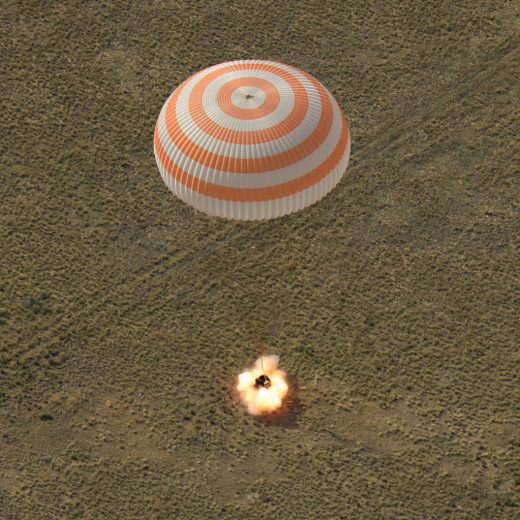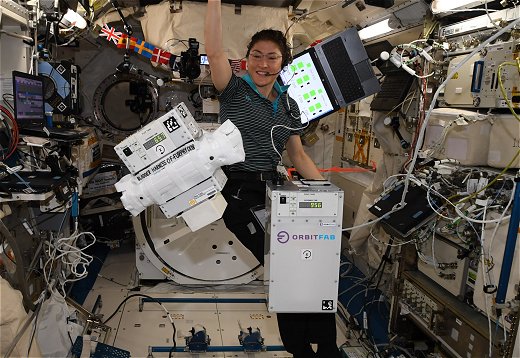Following up on yesterday’s roundup, the SpaceX Falcon Heavy successfully reached orbit and deployed a big batch of satellites on board. Three ISS crew members also made it back to Earth safely via their Soyuz spacecraft.
** SpaceX Falcon Heavy completes the company’s “most difficult launch ever”, as described by Elon Musk. While the center core rocket failed to make a successful landing, everything else went quite well, including the first-time capture of a nosecone fairing in a net. The biggest challenge – multiple firings of the upper stage engine after long coasting periods – went well. In total, 24 satellites were deployed.
The launch:
The landings of the two side boosters and the miss of the central core:
The fairing on the net of the SpaceX ship Ms. Tree (formerly Mr. Steven):
More at:
- SpaceX successfully catches first Falcon Heavy fairing in Mr. Steven’s/Ms. Tree’s net – Teslarati
- SpaceX nails twin Falcon Heavy booster landing but center core misses drone ship – Teslarati
- SpaceX caught Falcon Heavy rocket nose cone in net of high speed boat – CNBC
- NASA Technology Missions Launch on SpaceX Falcon Heavy – NASA
** The Planetary Society’s LightSail-2 finally makes it to orbit via the FH but the mission still has two hurdles ahead before the sail begins to accelerate from the push of sunlight. On July 2nd, the CubeSat is to be ejected from the Prox-1 carrier spacecraft and then about a week later the sail will be deployed: LightSail 2 Has Launched! | The Planetary Society
** Soyuz lands safely in Kazakstan with three ISS crew members:
- Three Station Residents Back on Earth After 204 Days in Space – Space Station/NASA
- Expedition 59 Trio Leaves Station for Ride to Earth – Space Station/NASA
- Soyuz MS-11 returns station crew to Earth after 204 days in space | collectSPACE
- Soyuz lands in Kazakhstan with international crew – William Harwood/Spaceflight Now
- Soyuz MS-11 lands successfully despite propulsion problem – RussianSpaceWeb.com

Highlights of the departure from the station and the landing:
** Chinese Long March 3B rocket launches navigation satellite: China launches new BeiDou satellite – CGTN
China sent a new satellite of the BeiDou Navigation Satellite System (BDS) into space from the Xichang Satellite Launch Center in its southwestern province of Sichuan on Tuesday. Launched on board a Long March-3B carrier rocket, the satellite was sent to a inclined geosynchronous earth orbit.
More at Chinese Long March 3B lofts Beidou-3I2 – NASASpaceFlight.com.
** India-based Bellatrix Aerospace raises $3M for development of smallsat rocket launchers and satellite propulsion systems.
- Indian startup Bellatrix Aerospace raises $3 million – SpaceNews.com
- IISc-based Startup Bellatrix Aerospace Raises $3 Mn To Build Re-Usable Space Launch Vehicles | IndianWeb2.com
- Bellatrix Aerospace raises $3 million in pre-Series A round – Hindu BusinessLine
“This funding will help Bellatrix to space qualify our products soon. During the coming months, we will be subjecting our thrusters to rigorous ground qualification tests and also work on key innovations that will make our products stand out. We will also be expanding to key global locations,” Rohan Ganapathy, co-founder at Bellatrix said.
** Misc. space transport items:
- Next Atlas 5 launch delayed by battery failure – Spaceflight Now – “The next launch of United Launch Alliance’s Atlas 5 rocket with the U.S. Air Force’s fifth Advanced Extremely High Frequency communications satellite, previously scheduled for Thursday, has been delayed to no earlier than July 12 to replace a failed battery on the vehicle.”
- STS-121 The Hardest Launch Part 4: Damage to the Heatshield | Wayne Hale’s Blog – The former Space Shuttle Program Manager recounts a case that illustrates the challenges in assessing risks for Shuttle launches in the aftermath of the Columbia loss.
- SpaceRyde wants to make access to space more available and more affordable | TechCrunch – Canada’s SpaceRyde startup is developing a smallsat launch system using a high-altitude balloon platform. “Earlier this year, SpaceRyde launched a stratospheric balloon carrying a scaled down version of their launch platform and rocket in Northern Ontario, Canada. The test wasn’t a complete success – a modification to the off-the-shelf rocket engine they used didn’t work exactly as expected – but it did demonstrate that their in-flight launch platform orientation tech worked as intended, and Safari says the malfunction that did occur is relatively easy to fix.Next up for SpaceRyde is to work towards a full-scale demonstration of their platform, which Safari says should happen sometime next year….“
- Univ. of Washington rocketeers take the prize at Spaceport America Cup – GeekWire – Washington’s Society for Advanced Rocket Propulsion won the top prize at this year’s Spaceport America Cup competition held at the NM spaceport. “The SARP team took the Judge’s Choice and Overall Winner Award at the world’s largest collegiate rocket engineering contest, which is run by the Experimental Sounding Rocket Association and drew 120 teams from 14 countries. Each team is required to design, build and fly a rocket that can reach 10,000 feet or 30,000 feet, depending on the contest category.“
** Raptor engine spotted at site of the Starship orbital demonstrator under construction in Florida.
Raptor seen at Cocoa FL pic.twitter.com/x3M01eKtKd
— Reagan Beck (@bluemoondance74) June 24, 2019
Another Starship test vehicle is in construction at Boca Chica Beach facility and Elon says flights will take place at both places:
Starship will do orbital launches from Boca Chica (near Brownsville) & Cape
— Elon Musk (@elonmusk) June 25, 2019
A comparison of the Starships in Florida and Texas:
We saw both SpaceX starships this month.
Here’s a side by side comparison of Florida & Texas builds.
@Teslarati #starship @SpaceX pic.twitter.com/4UkkXT7ICA
— TomCross (@_TomCross_) June 23, 2019
(Progress)🚀
Aerial shots from the #StarShip development in Florida. The #SpaceX crews are stepping into overdrive, it appears that they are tied(as of right now) with the Boca Chica crews.
Photos acquired from the SpaceX Facebook page, as to who took these is unknown. pic.twitter.com/v2rTp1uhEg— Austin Barnard🚀 (@austinbarnard45) June 22, 2019
Elon wants to speed up the Raptor and Starship program: SpaceX: Elon Musk Teases Rapid, Cheap Raptor Production to Get to Mars Fast | Inverse
SpaceX is planning to give its Mars-bound Raptor engine design a big production boost, CEO Elon Musk teased in a series of Twitter posts Monday. By the end of this year, Musk declared, the company is aiming to produce a new engine every 12 hours.
…
Musk suggested on Twitter that SpaceX is set to ramp up production for the engine “exponentially” soon. The sixth engine is almost done, and the firm is “aiming for an engine every 12 hours by end of year.” This should equate to around 500 engines per year, as Musk explained that a full year of production is around 70 percent of the peak daily rate.
====




